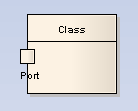
Ports define the interaction between a classifier and its environment. Interfaces controlling this interaction can be depicted using the Interface element. Any connector to a Port must provide the required interface, if defined. Ports can appear on a contained Part, a Class, or the boundary of a Composite element.
A Port is a typed structural feature or property of its containing classifier. Ports are typically used in Class Diagrams, Object Diagrams and Composite Structure Diagrams.
Toolbox Icon
![]()
See Also
OMG UML Specification
The OMG UML specification (UML Superstructure Specification, v2.0, p. 167) states:
"A port is a structural feature of a classifier that specifies a distinct interaction point between that classifier and its environment or between the (behavior of the) classifier and its internal parts. Ports are connected to properties of the classifier by connectors through which requests can be made to invoke the behavioral features of a classifier. A Port may specify the services a classifier provides (offers) to its environment as well as the services that a classifier expects (requires) of its environment."


